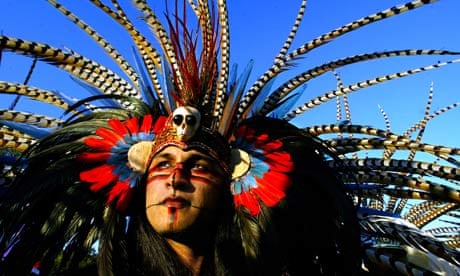Let's talk about cultural appropriation and cultural misappropriation. The two are very different. But sometimes the two get mixed up. The differences are essential, but not always easy to point out in our daily lives.
Cultural appropriation happens every day, especially in the world of fashion. It's the loose idea of borrowing, sharing and being inspired by other cultures. Cultural appropriation in this sense is an awesome thing. We learn, and we grow. Cultural misappropriation is a land of darkness. It's a place where one culture (most often one that has an historical record of oppressing other cultures) engages in the unauthorised taking of some aspects of another (most often a minority) culture.
Power factors shape the definitions of these two categories. Sharing is great. Unauthorised taking is not. Being inspired by an artist is great. Copying an artist and writing it off as your own is not. Appreciating Native American headdresses is great. Wearing a headdress when you have not been authorised to wear one is not. (And by "authorised" I mean you were gifted the right to wear one by a recognised leader of a Native American community in which headdresses are known to be status symbols. You probably haven't since it is hard to earn this right, so take the headdress off, you look silly.) See, these beautiful items belong to a people. They are restricted cultural items. Not just anyone can wear them. Read this article if you disagree with me.
With headdresses, in my mind the issue is black and white. But not every Native/Native-inspired item is so clear. So let's talk about this. Here are some rough guidelines:
"Can I wear turquoise?" – Yes, it's a beautiful stone, it's found throughout the world, and Native people do not claim ownership over its use.
"I have a small business, I want to label my work as Navajo, because I think it's based on Navajo cultures, can I?" – No, the Navajo nation has trademarked their name, you cannot use it any more than you can label your work as Prada. It's trademark violation.
"I have a small business, and I want to reprint Navajo textiles on my shirts and sell them as Native American T-shirts, can I?" – No, you cannot steal a design from another artist. Furthermore, you cannot label your work as Native American when it is not. There is a law against that.
"I found a tee with really cute cartoon Indians on it, can I wear it?" – We are not cartoons, it's not illegal, but please don't do it – it's just poor taste. Essentially stay away from anything that violates the law, perpetuates stereotypes, or disregards the wishes of Native people. It's a fuzzy world – the lines that divide appropriation and misappropriation can get blurry. It's important to keep the discussion line open. It's also important to do your research before making assumptions.
With Native American cultures inspiring and influencing the broader fashion industry these days (you can see it splattered all over fashion magazines and catalogues), I think it's time we start including actual Native American artists in this movement, rather than just our awesome inspiring culture. I mean, we (the people) are still alive and still exist.
Since the mainstream fashion world doesn't seem to be too keen on giving diversity a chance (and I mean in terms of representation of designers and models from diverse ethnic backgrounds), I've been blogging at Beyond Buckskin in hopes of creating a platform for Native artists – a platform that has been (and continues to be) denied to Native American fashion designers.
It is time that Native American artists reclaim their right to determine what is "Native American" when it comes to fashion. As we have seen in recent popular white culture and hipster movements, this label has been misappropriated (taken without authorisation) and misused. This situation has created important conversations about issues of cultural appropriation, but the debate has also stolen attention from the Native cultures and individual artists who produce "Native" designs, clothing and accessories.
In many ways, our cultures have been reduced to nothing more than patterns on a shirt. There's more to us than that, and I hope to rehumanise Native American designers and their work by giving them an opportunity to explain the history and inspiration behind their craft. These explanations are important because they offer new self-imposed definitions of what is "Native".
I want to provide a means to bring Native artists and their work to the forefront by providing a space to present the people and history behind the trend. It gives them the opportunity to say, "This is Native fashion." With the help of this site, Native artists and designers will be able to create new markets for themselves by broadening the set of images associated with "Native America". Eventually Ralph Lauren, Proenza Schouler and Urban Outfitters will no longer dictate the public's taste for "Native" fashion. Native Americans will. It's about time we start buying Native-made.

Comments (…)
Sign in or create your Guardian account to join the discussion